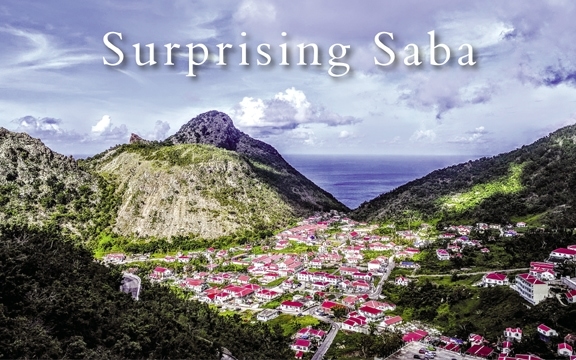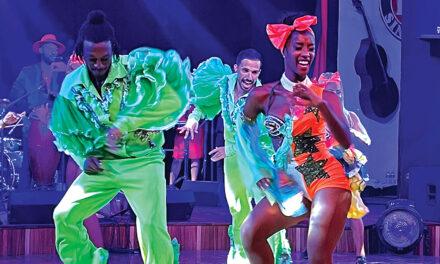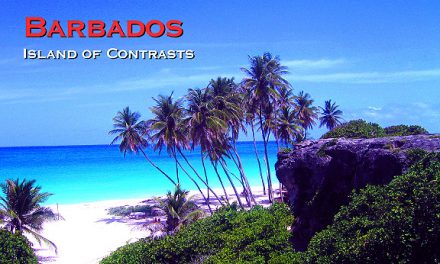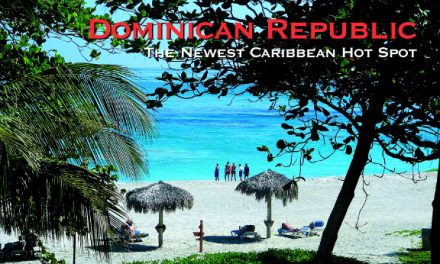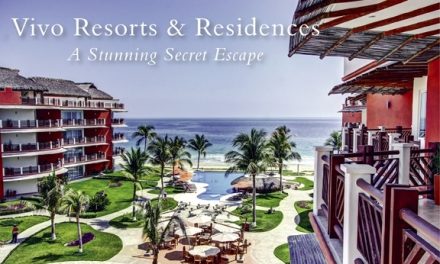Saba
Surprising Saba
by Susan Campbell

An abrupt arrival
I am a tad white-knuckled as our tiny Winair prop plane readies for landing after its ten- minute flight from St. Maarten. The apprehension comes from the knowledge that at a mere 1,300 feet, the runway at Juancho E. Yrausquin Airport is one of the shortest on the planet, and it abruptly ends on a cliff perched over the sea! We hit the ground with a small thud, fishtailed a bit, and then stopped cold, much to our collective relief. This is one of the only ways to get to Saba. The other is a ferry from St. Maarten, but it can be a rough passage at times, so if you are prone to seasickness- take the plane.
Saba (pronounced say-beh) rises out of the Caribbean Sea like a giant Jurassic turtle, ascending from the ocean’s depths with jagged volcanic cliffs crawling up into emerald slopes and culminating in an ethereal white halo of cloud forest at its highest peak. It’s a Dutch Caribbean island- once part of the now dissolved Netherlands Antilles- and now a special municipality of the Dutch kingdom. But unless you’re an avid diver or hiker, you’ve probably never heard of it. And that’s a shame, because it’s full of surprises. And it’s one quirky little rock.
Surprising first impressions
The first surprise is the road. And that’s what they call it “The Road”, though it’s officially named after Josephus “Lambee” Hassell the Dutch engineer who built it despite great odds. In fact, it was called “the road that couldn’t be built.” And it’s easy to see why.
Tightly coiled like an asphalt snake, the road winds around to the top with an impossibly vertical tilt. Visitors are best to take a local cab because this road is no easy drive. Along the way you can look down on ”The Bottom” – a checkerboard tablecloth of uniform white houses with red roofs nestled in one of the rare valleys. But this is not really “the bottom” of the island; the port area is the lowest part of the island. Some say the name came from the Dutch word for bowl, which makes more sense given that this settlement is actually halfway up the mountain! Then you continue the climb to reach the “top” settlement which is called Windwardside, and that’s where the majority of commerce, dining, culture, and accommodations are located.
At every turn you can see how hard it must have been to eke out an existence on this rocky vertical outpost. Though the volcanic soil is lush and fertile, which makes for growing sustenance fairly easy, getting things from the sea to the hillside communities was very hard. Though you can take a hike down to see it, the view of “The Ladder” from the sea gives you the best perspective on the sheer magnitude of difficulty that they were up against. The ladder is a steep set of 800 steps carved right into the rock from the sea cliff where the ships would unload cargo. “Butlers” would hand-cart the goods straight up to a small customs house which is actually still standing there. Think pianos, mahogany furniture, and the materials needed to build the huge stone church at one of the island highest peaks called “Zion”. The goods then had to be transported by man and mule through difficult winding trails up to their destination. So one can understand why Zion was renamed “Hell’s Gate”. But Sabans are known for their grit and determination, and they found all kinds of ways to create a self-supporting little nation out of this unforgiving tropical outpost.
Pastimes and pleasures
Hiking is one of the main draws here, there are many trails, but the most famous is the 1,000 plus steps up to the 2,877 ft. summit of Mt. Pleasant. A guide is highly recommended for all hikes and you can get all the information at The Trail Shop in Windwardside. Diving is also a very popular pastime; the waters surrounding the entire island are a protected marine park and full of resplendent marine life and underwater mountains. I am not certified yet, so I opted for the snorkel trip with Sea Saba. I especially enjoyed swimming with the sea turtles. I saw over a dozen juveniles that come to the shallow area they call “the nursery”. It was an enchanting trip.
Dining on this island is also delightful. The specialty being the Saban spiny lobster, and their locally made Saba Spice Rum is out of this world. (The recipe is a secret handed down through the generations.) Saba is also a very arty island, with the most famous artist being Heleen Cornet who has shown internationally. You can see a lot of her work in the Five Square Gallery in Windwardside. You’ll also find a few museums in Windwardside, and the archeological foundation SABARC at the Heritage Centre gives guided history walks. Visitors can also learn how to make glass bead art with workshops at Jobean Glass Cottage, and you can also watch the Saba lace ladies at work at Kakona arts shop Thursday afternoons. This unique lacework was once one of the island’s most important exports, and you can purchase lace souvenirs at the island’s little gift shops. And the Jewel Cottage has a seriously impressive collection of fine handmade pieces using gems from around the world.
More surprises
Another surprise you might note is that almost every house has a graveyard in the garden! The island has been populated with many Irish and Scottish settlers, and the tradition of keeping their dearly departed close to home seems to have stuck there. Also surprising is that this tiny island boasts an extremely highly regarded academic institution that attracts international students. The Saba University School of Medicine has garnered numerous accolades for its very high standards. But for me the biggest surprise of all was the karaoke!
Every Friday night, Scout’s Place is the place to be for state-of-the-art equipment, a library of thousands of songs in multiple languages, and special effects like smoke machines- it’s a karaoke lover’s heaven. And it’s very competitive! Each fall they crown the annual “Sabaoke Idol” winner with pomp and circumstance, so better bring your A game because these singers are in it to win it!
Where to stay
Most of the hotels are cozy cottage style affairs, except the more upscale Queens Gardens and some very unique boutique properties like Spyglass Villa on a cliff, and Villa Orchid, which is awash in over 200 species of those fragrant flowers. The Pyramid House is also a boutique villa rental, ideal for yoga retreats with a meditation circle ensconced in nature. Then there is Convent Cottage with its amazing interior décor. Once a small home for Dominican nuns- it’s a two-bedroom rental house chock full of incredible antiques and special finds personally curated from owner Mark Johnson’s world travels.
I stayed at Julianna’s Hotel; I loved the view from my charming little cottage overlooking the lush cliffs to the sea, and their “Tipsy Goat” pool bar there is also popular spot for local happy hours. I was not there long, but I found a stay on Saba to be indeed like a breath of fresh air. It’s easy to see why the island is dubbed “The Unspoiled Queen” of the Caribbean. It truly is.
www.sabatourism.com
Click on cover to view published article

